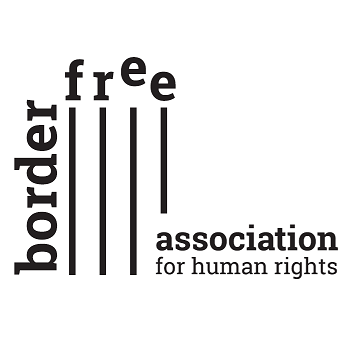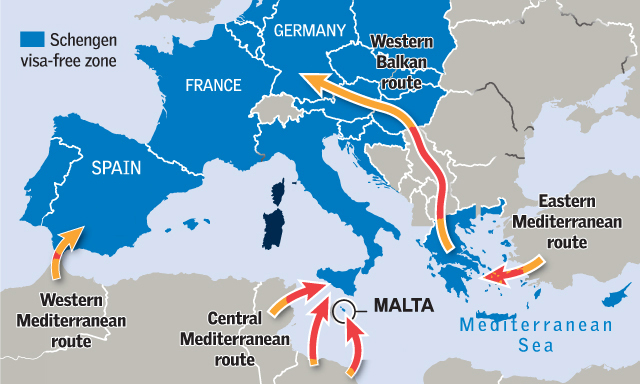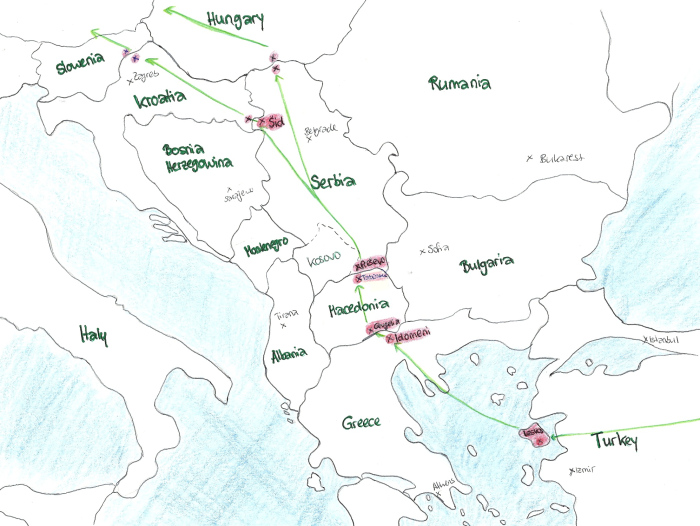*Unbedingt lesenswert!*
Ein engagierter, informativer und inspirierender Bericht von Steffi Reist, die einen ganzen Monat als Freiwillige in Presevo verbracht hat. „I am not a politician, but I care about people.“ Schreibt sie.
Steffi, dein Engagement, dein Mut und dein grosses Herz sind einfach bewundernswert! Danke für alles!
Open borders
Those who do not remember the past are condemned to repeat it. – George Santayana
The past month I have been working as a volunteer for Borderfree Association, a Swiss NGO which offers humanitarian aid to all refugees and migrants arriving in Preševo, no matter where they are from. Back home in Switzerland I talked about this topic with people in my close surrounding and realized, that most people don’t even know what’s going on in southeastern Europe. Therefore I’d like to share some of my experiences and insights with you.
Preševo is a small village in south Serbia, mostly inhabited by ethnically Albanians and loads of street dogs. The very recent history of conflict between Serbians and Albanians is still perceptible. Preševo now happens to be the first stopover in Serbia for refugees from Syria and Iraq, who are crossing the so called Balkanroute to reach Europe. By the time I was in Preševo, only people from Syria, Iraq and for a short while Afghanistan were allowed to register in the camp. Lucas, one of my Borderfree colleagues wrote a very interesting article about our work in Preševo, you can find it here .
But let’s zoom out a bit and look at the bigger picture of the current so called refugee crisis. This video gives you a short and simple explanation of the current situation in Syria. And the same about Iraq.
But why do people travel through all those countries in the Balkans, instead of just flying wherever they want? Today there is no way to apply for asylum from your country of origin and without a visa you cannot board a plane and fly to Europe. This leads people to go on very dangerous and expensive journeys and enter countries illegally. In the last couple of months, the most used route to enter Europe was by Mediterranean Sea. People leave Turkey by small wooden or rubber boats and reach the Greek Islands (for example Lesvos), where refugees are allowed to get registered and continue their way towards Germany. The distance between the Turkish coast and the Greek Island Lesvos is about 8 Km. There is a regular ferry covering this distance from Ayvalik (TR) to Lesvos (GR) daily. It takes 90 minutes and costs 15 Euros (source: feribot.net). But for the same reason that refugees don’t fly to the country of their choice, they cannot take the ferry: without visa, there is no legal way to enter the European Union. So they pay smugglers (between 900 and 2’000 Euros per Person) and then board a very small and overcrowded boat and are sent to the sea. Depending on the weather conditions, the passage is more or less long and dangerous. 464 people died by attempting this dangerous crossing since beginning of 2016 (source UNHCR). According to the IOM more than 3’770 people were reported to have died trying to cross the Mediterranean in 2015!
Once a person reaches such a Greek Island, the European odyssey starts. They have to get registered in every country they come through, get a stamp and the right paper. If they don’t bring an official ID or passport from Syria or Iraq, this paperwork can become very difficult. And unlike settled residents and tourists, asylum seekers do not have the right to move freely within the EU’s Schengen area. So from the Island Lesvos the journey goes to Idomeni, which is the last point before the Greek-Macedonian border. After crossing that border, people have to get registered in the camp of Gevgelia and then take a train to Tabanovce, at the Macedonian-Serbian border. Reached the border, they have to walk 4 Kilometers to get to the Serbian side of the border. A bus will pick them up and bring them to Preševo, the first village in Serbia, where they have to get registered again. And this game is to be continued in Serbia, Croatia, Slovenia and Austria until they reach Germany. And reaching Germany is notabene not the end of the story, but just the beginning…
As of 24th February 2016, Austria closed its borders and caused a crucial domino effect. Countries like Slovenia, Croatia, Serbia and Macedonia followed the Austrian decision by closing their borders as well. As a consequence, people got stuck in Idomeni at the Greek-Macedonian border. Idomeni has a population of 309 citizens, the refugee camp is made for 1’500 people. Today there are about 15’000 people in this area, without access to food, shelter, sanitary arrangements and medical care. It’s mid March, around 0-8 degrees and mostly rainy. The misery is huge.
“Those who do not remember the past are condemned to repeat it”. I’ve read this sentence on a wall in Auschwitz, when I visited the former concentration camp in Krakow, Poland, last October. If we look back in history, we will see that closed borders have never led our world to be a better place. Building fences to protect our own comfort zone and letting down people fleeing war is wrong legally, economically and morally.
“But what can I do?” you may ask.
That’s a question I’ve asked myself for a long time and still do. I think there is a lot we can do and I will mention some of it here as an input and food for thought:
Open your eyes
Don’t look away. Read the news, ask questions and get in touch with people (refugees and volunteers) who know more details. By accepting that we have a problem and learning more about it, you will raise awareness of the situation and will be more likely to change something.
Open your wallet
If you’re working hard and are busy with all your everyday life obligations, you can donate some of your money to let others do their job in the field. I now know that every coin counts. I will spend the whole month of April working as a volunteer in Greece, so if you trust me, you can give me some money and I will bring it to the people in need.
*Highly recommended to read! – Report in English*
A dedicated, informative and inspiring report from Steffi Reist, volunteer for a whole month in Presevo. „I am not a politician, but I care about people.“ Her words.
Steffi, your engagement, your courage and your big heart are admirable! Thank you for everything!
Open borders
Those who do not remember the past are condemned to repeat it. – George Santayana
The past month I have been working as a volunteer for Borderfree Association, a Swiss NGO which offers humanitarian aid to all refugees and migrants arriving in Preševo, no matter where they are from. Back home in Switzerland I talked about this topic with people in my close surrounding and realized, that most people don’t even know what’s going on in southeastern Europe. Therefore I’d like to share some of my experiences and insights with you.
Preševo is a small village in south Serbia, mostly inhabited by ethnically Albanians and loads of street dogs. The very recent history of conflict between Serbians and Albanians is still perceptible. Preševo now happens to be the first stopover in Serbia for refugees from Syria and Iraq, who are crossing the so called Balkanroute to reach Europe. By the time I was in Preševo, only people from Syria, Iraq and for a short while Afghanistan were allowed to register in the camp. Lucas, one of my Borderfree colleagues wrote a very interesting article about our work in Preševo, you can find it here .
But let’s zoom out a bit and look at the bigger picture of the current so called refugee crisis. This video gives you a short and simple explanation of the current situation in Syria. And the same about Iraq.
But why do people travel through all those countries in the Balkans, instead of just flying wherever they want? Today there is no way to apply for asylum from your country of origin and without a visa you cannot board a plane and fly to Europe. This leads people to go on very dangerous and expensive journeys and enter countries illegally. In the last couple of months, the most used route to enter Europe was by Mediterranean Sea. People leave Turkey by small wooden or rubber boats and reach the Greek Islands (for example Lesvos), where refugees are allowed to get registered and continue their way towards Germany. The distance between the Turkish coast and the Greek Island Lesvos is about 8 Km. There is a regular ferry covering this distance from Ayvalik (TR) to Lesvos (GR) daily. It takes 90 minutes and costs 15 Euros (source: feribot.net). But for the same reason that refugees don’t fly to the country of their choice, they cannot take the ferry: without visa, there is no legal way to enter the European Union. So they pay smugglers (between 900 and 2’000 Euros per Person) and then board a very small and overcrowded boat and are sent to the sea. Depending on the weather conditions, the passage is more or less long and dangerous. 464 people died by attempting this dangerous crossing since beginning of 2016 (source UNHCR). According to the IOM more than 3’770 people were reported to have died trying to cross the Mediterranean in 2015!
Once a person reaches such a Greek Island, the European odyssey starts. They have to get registered in every country they come through, get a stamp and the right paper. If they don’t bring an official ID or passport from Syria or Iraq, this paperwork can become very difficult. And unlike settled residents and tourists, asylum seekers do not have the right to move freely within the EU’s Schengen area. So from the Island Lesvos the journey goes to Idomeni, which is the last point before the Greek-Macedonian border. After crossing that border, people have to get registered in the camp of Gevgelia and then take a train to Tabanovce, at the Macedonian-Serbian border. Reached the border, they have to walk 4 Kilometers to get to the Serbian side of the border. A bus will pick them up and bring them to Preševo, the first village in Serbia, where they have to get registered again. And this game is to be continued in Serbia, Croatia, Slovenia and Austria until they reach Germany. And reaching Germany is notabene not the end of the story, but just the beginning…
As of 24th February 2016, Austria closed its borders and caused a crucial domino effect. Countries like Slovenia, Croatia, Serbia and Macedonia followed the Austrian decision by closing their borders as well. As a consequence, people got stuck in Idomeni at the Greek-Macedonian border. Idomeni has a population of 309 citizens, the refugee camp is made for 1’500 people. Today there are about 15’000 people in this area, without access to food, shelter, sanitary arrangements and medical care. It’s mid March, around 0-8 degrees and mostly rainy. The misery is huge.
“Those who do not remember the past are condemned to repeat it”. I’ve read this sentence on a wall in Auschwitz, when I visited the former concentration camp in Krakow, Poland, last October. If we look back in history, we will see that closed borders have never led our world to be a better place. Building fences to protect our own comfort zone and letting down people fleeing war is wrong legally, economically and morally.
“But what can I do?” you may ask.
That’s a question I’ve asked myself for a long time and still do. I think there is a lot we can do and I will mention some of it here as an input and food for thought:
Open your eyes
Don’t look away. Read the news, ask questions and get in touch with people (refugees and volunteers) who know more details. By accepting that we have a problem and learning more about it, you will raise awareness of the situation and will be more likely to change something.
Open your wallet
If you’re working hard and are busy with all your everyday life obligations, you can donate some of your money to let others do their job in the field. I now know that every coin counts. I will spend the whole month of April working as a volunteer in Greece, so if you trust me, you can give me some money and I will bring it to the people in need.
[:]



Neueste Kommentare